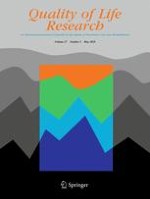28-02-2018
Health state utilities and subjective well-being among psoriasis vulgaris patients in mainland China
Gepubliceerd in: Quality of Life Research | Uitgave 5/2018
Log in om toegang te krijgenAbstract
Purpose
To investigate the validity of direct and indirect health state utility (HSU) and subjective well-being measures in psoriasis vulgaris patients.
Methods
A convenience sampling framework was used to successively recruit patients with psoriasis vulgaris from the outpatient clinics of a tertiary hospital in Changsha, Central South China. Participants completed time trade-off (TTO), standard gamble (SG), the five-level EQ-5D (EQ-5D-5L), the WHO-5 well-being index, and the psoriasis disability index (PDI). The concurrent and known-groups validity of HSUs and well-being index in psoriasis patients were firstly studied. The agreements among HSUs and the relationship between HSU and well-being measures were further explored.
Results
A valid sample of 343 patients was analyzed. Mean HSU and well-being scores elicited from the EQ-5D-5L/TTO/SG and WHO-5 were 0.90/0.85/0.88 and 13.69, respectively. The Spearman correlation (concurrent validity) was the strongest between PDI and WHO-5 (r = 0.45), followed by with EQ-5D-5L (0.38), SG (r = 0.20), and the TTO (r = 0.18). The pairwise intraclass correlation coefficients among the three HSU measures were < 0.30. The known-groups validity was evident in all measures except for the SG. Exploratory factor analysis further suggests a complementary relationship between the EQ-5D-5L and WHO-5.
Conclusions
There is a poor agreement between direct and indirect methods on measuring HSU with psoriasis vulgaris. Results from this study recommend that the EQ-5D-5L is the most preferred method to elicit HSU from psoriasis vulgaris patients in mainland China. It is important to further analyze the subjective well-being in addition to the HSU to fully understand the impact of psoriasis.
